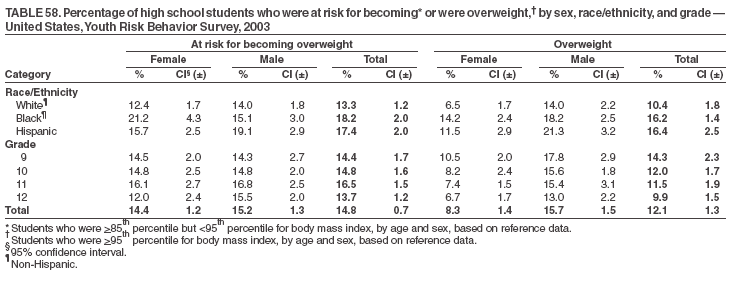
|

Errata: Vol. 53, No. SS-2
In the MMWR Surveillance Summary, "Youth Risk Behavior Surveillance --- United States, 2003," the following
errors occurred in the overweight and at risk for overweight data.
On page 1, the last sentence of the abstract under "Results and Interpretation" should read, "In 2003, a total of 21.9% of high school students had smoked cigarettes during the 30 days preceding the survey; 78% had not eaten >5 servings/day
of fruits and vegetables during the 7 days preceding the survey; 33.4% had participated in an insufficient amount of
physical activity; and 12.1% were overweight.
On page 25, the text should read as follows:
Overweight and Weight Control
At Risk for Overweight
Nationwide, 14.8% of students were at risk for becoming overweight (Table 58). Overall, the prevalence of being at risk for overweight was higher among black (18.2%) and Hispanic (17.4%) than white (13.3%) students; higher among black
female (21.2%) than white female (12.4%) and Hispanic female (15.7%) students; and higher among Hispanic male (19.1%)
than white male (14.0%) students. Overall, the prevalence of being at risk for overweight was higher among
11th grade (16.5%) than 12th grade (13.7%) students and higher among
11th grade female (16.1%) than
12th grade female (12.0%) students. Prevalence of being at risk for overweight ranged from 11.0% to 16.7% across state surveys (median: 14.5%) and from 14.2% to 20.9% across local surveys (17.4%) (Table 59).
Overweight
Nationwide, 12.1% of students were overweight (Table 58). Overall, the prevalence of being overweight was higher
among male (15.7%) than female (8.3%) students; higher among white male (14.0%) and Hispanic male (21.3%) than white female (6.5%) and Hispanic female (11.5%) students, respectively; and higher among
9th grade male (17.8%), 10th grade
male (15.6%), 11th grade male (15.4%), and 12th grade male (13.0%) than 9th grade female (10.5%),
10th grade female (8.2%), 11th grade female (7.4%), and
12th grade female (6.7%) students, respectively. Overall, the prevalence of
being overweight was higher among black (16.2%) and
Hispanic (16.4%) than white (10.4%) students; higher among black female (14.2%)
and Hispanic female (11.5%) than white female (6.5%) students; and higher among black male (18.2%) and Hispanic male (21.3%) than white male (14.0%) students. Overall, the prevalence of being overweight was higher among 9th grade (14.3%) and 10th grade (12.0%) than
12th grade (9.9%) students; higher among
9th grade (14.3%) than 11th grade (11.5%) students; higher among 9th grade female (10.5%) than 11th grade female (7.4%) and
12th grade female (6.7%) students; and higher among 9th grade male (17.8%) than
12th grade male (13.0%) students. Prevalence of being overweight ranged from 7.0%
to 15.7% across state surveys (median: 11.1%) and from 9.3% to 20.5% across
local surveys (median: 13.8%) (Table 59) (Figure 8).
On page 28, the last sentence of the first paragraph under "Discussion" should read, "In addition, 6.6 million high school students had ever had sexual intercourse, and 1.7 million were overweight.
On page 87, Table 58 should be replaced by the following table:
Table 58

Return to top.
Use of trade names and commercial sources is for identification only and does not imply endorsement by the U.S. Department of
Health and Human Services.
References to non-CDC sites on the Internet are
provided as a service to MMWR readers and do not constitute or imply
endorsement of these organizations or their programs by CDC or the U.S.
Department of Health and Human Services. CDC is not responsible for the content
of pages found at these sites. URL addresses listed in MMWR were current as of
the date of publication. |
Disclaimer
All MMWR HTML versions of articles are electronic conversions from ASCII text
into HTML. This conversion may have resulted in character translation or format errors in the HTML version.
Users should not rely on this HTML document, but are referred to the electronic PDF version and/or
the original MMWR paper copy for the official text, figures, and tables.
An original paper copy of this issue can be obtained from the Superintendent of Documents,
U.S. Government Printing Office (GPO), Washington, DC 20402-9371; telephone: (202) 512-1800.
Contact GPO for current prices.
**Questions or messages regarding errors in formatting should be addressed to
mmwrq@cdc.gov.
Page converted: 6/22/2005
|

|
